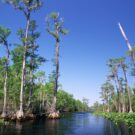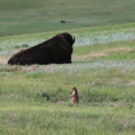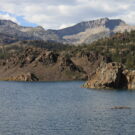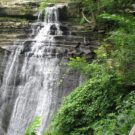Kisatchie National Forest
Kisatchie National Forest spreads over 604,000 acres in five Ranger Districts. Louisiana’s only national forest is divided into six separate sections. Kisatchie were members of a Native American tribe The Kisatchie name comes from a Native Americans tribe called Kichai. Members of this tribe called themselves “Kitsatchie.” Bald cypress trees have knees Bald cypress trees thrive in this forest. One fun thing about bald cypresses is that these trees have “knees” that are a special kind of root. Needle-like leaves turn tan or orange in the autumn and fall early in the season. These giant trees grow to 120 feet tall and live up to 600 years. Pine trees scent the air. Groves of bald cypress trees, bayous, prairies, and gently rolling hills...
Read MoreTheodore Roosevelt National Park
If your family is planning a vacation to North Dakota, consider adding a visit to Theodore Roosevelt National Park. Three very different sections in the park The park was first established as a memorial park in 1947 and renamed as a national park in 1978. Three completely different sections make up the park: the North Unit is near Watford City; The South Unit is near Medora; and Roosevelt’s Elkhorn Ranch sits in the middle. The Maah Daah Hey Trail All three sections are connected by the Maah Daah Hey Trail, which in the Mandan Indian language means “an area that will be around for a long time.” This trail is 101 miles long. It connects with seven campgrounds. If you walk the trail, you may see horseback riders, hikers, and bicycle riders. Teddy...
Read MoreWind Cave National Park
Over 600,000 people visit Wind Cave National Park in South Dakota every year. Strong winds at the cave’s entrance gave the park its name. In fact, according to legend, wind blew the hat off one of the Bingham brothers who discovered the cave when he stood at the mouth of the cave. 135 miles of cave tunnels Explorers have found over 135 miles of passages inside the cave, making Wind Cave one of the longest in the world. Another unusual thing about the cave is boxwork, formations that look like honeycombs. Cave Tours Several different ranger-led cave tours allow guests to explore Wind Cave. A two-hour candlelight tour takes visitors back in time while exploring by candlelight, but you must be at least eight to join this tour. Summer Campfire Programs Campfire...
Read MorePetrified Forest National Park
Over 600,000 tourists visit the Petrified Forest National Park in Arizona every year. They find the amazing sight of trees that lived long ago turned to stone. Not a normal forest When we think of a forest, we usually think of a variety of tall trees growing close together. Trees in the Petrified Forest lay on the ground, often in clumps. The trees lived long ago beside a river. After the trees died and toppled over, the flooded river took them downstream where mud buried them. Over time the wood became stone, mostly quartz. Rainbow Forest Most petrified wood is brown or black. The Rainbow Forest, one of the six forests in the park, contains pink, orange, or red petrified wood. Tourists may find almost every color of the rainbow. Rock Shops Though the...
Read MoreYosemite National Park
President Abraham Lincoln signed a bill to preserve Yosemite Valley and a grove of sequoia trees that he had never seen on June 10, 1864. The first tourists to Yosemite Valley traveled four to five days by carriage, horse, and foot from San Francisco. Yosemite known for beautiful waterfalls and sequoias Yosemite National Park was established in 1890 and has 3,700,000 visitors every year. The park is best known for its waterfalls, but also has ancient giant sequoias, vast wilderness, meadows, and valleys. Yosemite Falls is North America’s tallest waterfall At 2,425 feet, Yosemite Falls is the tallest waterfall in North America. Melting snow feeds Yosemite Falls and it usually reaches its peak in late May. Giant Staircase The Merced River drops over...
Read MoreCuyahoga Valley National Park
Cuyahoga Valley National Park, established in 2000, is one of our newest national parks. Just a short drive from Akron or Cleveland in Ohio, 2,500,000 people visit the park each year. The winding Cuyahoga River is a U-shaped river. (Cuyahoga means “crooked” in the Iroquois language.) The unique part about this river is that, for twenty-two miles, it flows both north and south. The river winds past farmland, forests, and rolling hills. One of the most popular tourist attractions at the park is the Ohio & Erie Canal that runs through it. Built in the early 1800s by German and Irish immigrants, twenty miles of the canal are within the park. Hike or bike along the Towpath Trail where mules used to pull the canal boats over a century ago. Parts of the...
Read More










